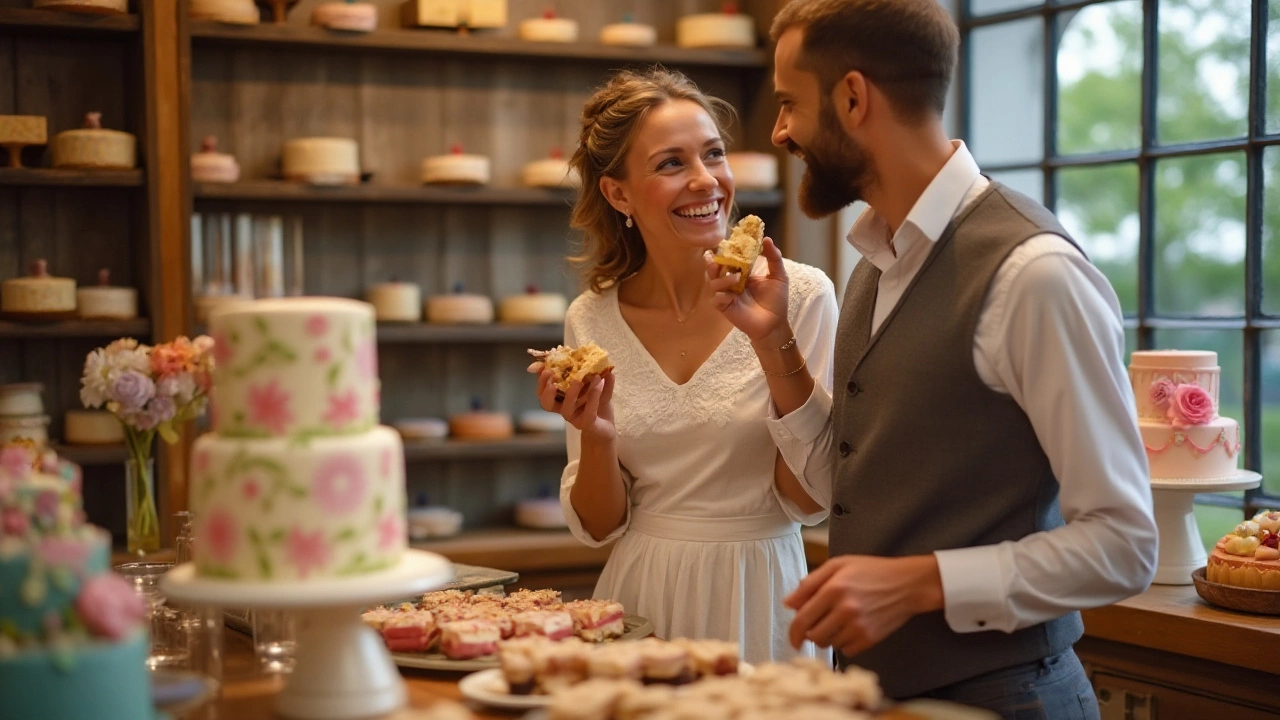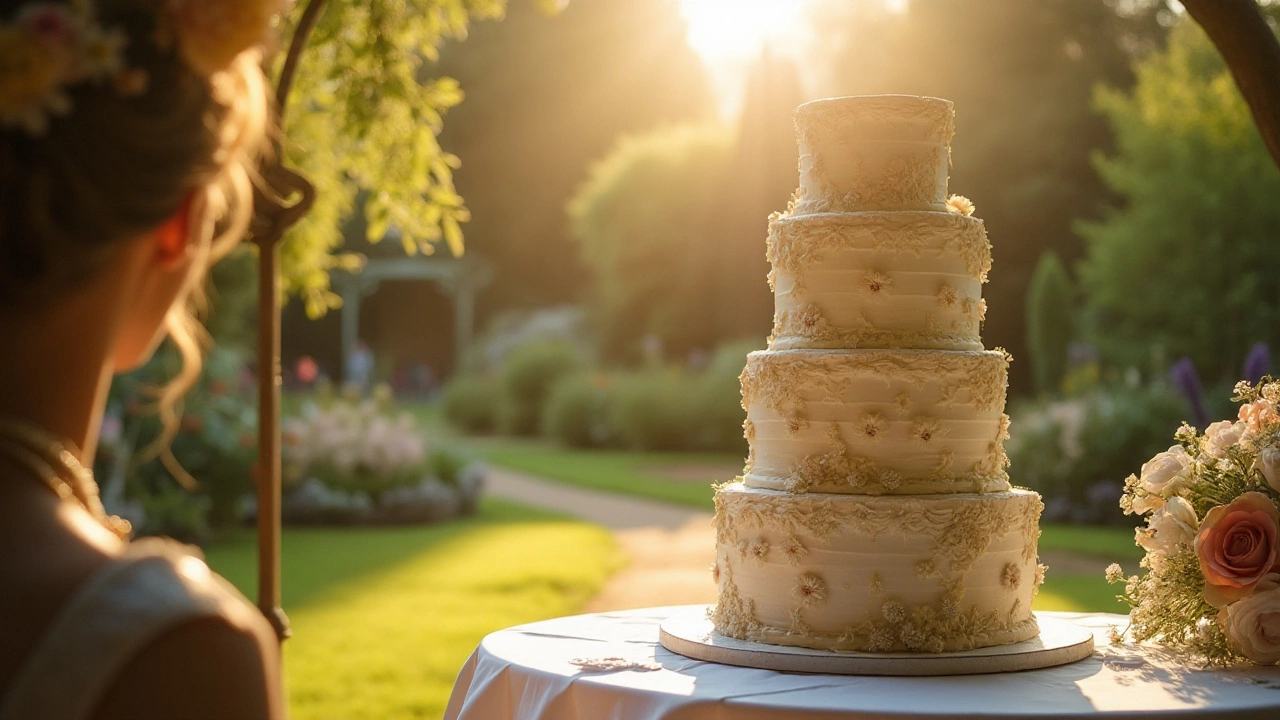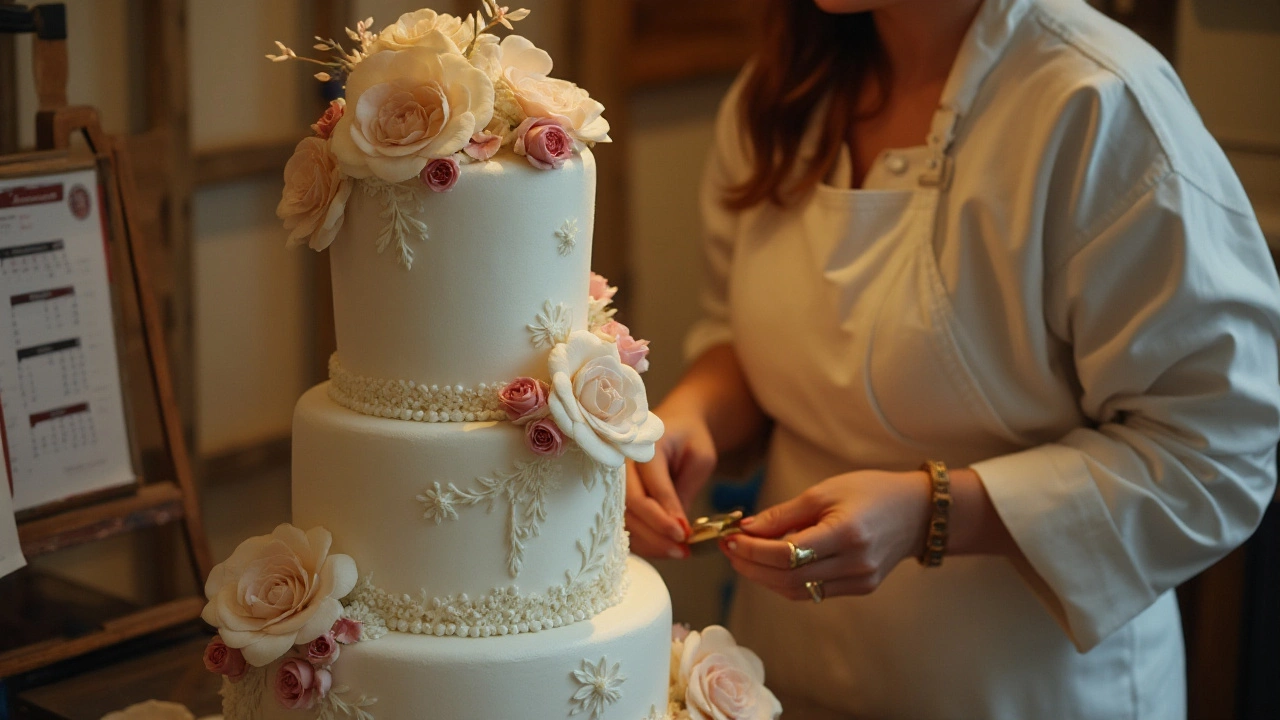One of the most magical elements of any wedding is undoubtedly the cake, capturing both the eyes and the taste buds of every guest. But behind every eye-catching, delicious tower of sweetness is a timeline crafted with precision.
For couples and cake makers alike, understanding when to start the cake-making process is crucial to ensure it arrives at the venue in perfect condition. From fundamental elements like flavors and fillings to elaborate decorations, each component demands a different time frame.
How early should you begin baking to strike the perfect balance between flavor and freshness? What steps need a bit of extra time to achieve those personalized touches? This guide navigates through the intricate timeline of wedding cake preparation, ensuring that every bite is as memorable as the day itself.
- Understanding Cake Components
- Timeline for Baking and Decoration
- Storage Tips for Freshness
- Custom Designs and Their Requirements
- Communication with Your Baker
Understanding Cake Components
The art of crafting a wedding cake involves more than just mixing flour, sugar, and eggs. Each cake is a delightful puzzle made up of various components, each playing a pivotal role in its overall appeal and taste. At its core, a wedding cake comprises multiple layers, typically of sponge cake, that are carefully prepared and skillfully assembled to offer both stability and deliciousness. These layers, delicate yet substantial, need to offer the right amount of moisture while maintaining structure, so they don't crumble under the weight of intricate designs. Selecting the right type of sponge, like a classic vanilla or a rich red velvet, is crucial to laying a solid foundation.
The fillings between these layers add richness and texture that can dramatically alter the cake's appeal. Popular choices such as buttercream, ganache, or fruit preserves provide a lusciousness that complements the cake while adding a burst of flavor in each bite. For those desiring more exotic tastes, infusions of unique flavors like lavender or champagne within the fillings can take the cake experience to new heights. However, choosing fillings requires balancing taste with an understanding of how well they complement the cake's outer layer of icing or fondant.
Speaking of the outer layers, the icing or fondant covering a wedding cake isn’t just for decoration—though it certainly holds the cake's aesthetic appeal. This outer layer serves both functional and artistic purposes, acting as a canvas for secret messages or intricate patterns that echo the wedding's theme. There’s a striking difference between the ease of working with fondant, which allows for perfect, smooth finishes, and the more textured charm of buttercream, which speaks to more rustic themes. The choice of icing impacts not just the cake's look but the timing required for decoration, as some types need longer to set perfectly.
All these components contribute to the timeline needed for cake preparation—not to mention the complexity involved in personalizing designs. As celebrity baker Duff Goldman once noted, creating a memorable cake is about more than following a recipe.
"A cake is not just a cake; it reflects the couple's story, their tastes, and the bond between them," he observed, highlighting the significance of each element in telling a story.Therefore, understanding these different components is vital for both the cake maker and the couple, ensuring that the final creation resonates with harmony and beauty, making it more than just a dessert but an experience unto its own.
Timeline for Baking and Decoration
Creating a wedding cake is as much an art as it is a science. The timeline for baking and decorating a wedding cake involves thoughtful coordination and creativity. For those stepping into the delightful world of wedding cake preparation, knowing precisely when to start each phase can transform stress into a sweet success story. The process requires managing elements like ingredient freshness, baking time, and intricate decorating to ensure a seamless blend of beauty and taste on the big day.
Typically, the process begins with the baking of the cake layers. Most bakers agree that starting the baking process two to three weeks before the wedding date is ideal for sponges that will be frozen and later decorated. Freezing the cake can help lock in moisture and enhance the final texture, which is a vital factor in delivering that sought-after luscious bite. However, for fruit cakes enriched with alcohol, an earlier start, perhaps even three months prior, is common as these cakes develop flavor over time through maturation. As one seasoned baker aptly notes,
"A well-prepared cake can stand tall and proud, just like the couple it represents."
Once the baked layers are ready, it's time to move to the icing and decoration stage, typically done about a week before the wedding. This phase is where artistry comes alive, requiring precision and an eye for detail to create edible works of art. Buttercream and fondant are popular choices, each offering different textures and finish. The icing not only acts as a sweet canvas for decorations with flowers, piping, or intricate lace designs but also seals in freshness, helping maintain the cake's moistness and flavor balance.
Decorating a wedding cake often demands extra attention when it involves custom designs, which may need a couple of more days of trial and effort. This is particularly pertinent for cakes with elaborate sugar flower arrangements or intricate patterns, requiring meticulous handwork. It's crucial to ensure all components, like sugar flowers or edible images, are prepared and stored in advance to prevent any last-minute rush or unexpected setbacks.
As the cake takes shape, storage becomes paramount to preserve its freshness and quality. Proper storage methods from cool temperatures to airtight containers shield the cake from moisture loss or flavor alteration, ensuring the cake's authentic taste shines through during the festivities. Heading close to the wedding day, a baker might need to bring everything together at the venue. Contact with the couple for final touches like adding fresh flowers makes the cake a true reflection of their love story.
The right timing and preparation of a cake making timeline allow both makers and lovers of cake to ensure a delightful centerpiece that encapsulates the joy of the day. The culmination of careful planning, crafting, and attention results in a cake that stands not just as a delicious treat but as a treasured part of the wedding memories.

Storage Tips for Freshness
Preserving the freshness of a wedding cake is not just about knowing the right recipes but also understanding how to store each intricate layer effectively. The journey from the oven to the altar can span days, especially when factoring in the time needed for decoration. Each part of the cake, from the sponge to the frosting, requires certain conditions to maintain its best possible state. Refrigeration and temperature control play vital roles in this process, guardians against both staleness and structural slippage. Proper storage can determine how well the cake holds up, both in structural integrity and flavor profile.
The key to maintaining your cake’s charm lies in knowing what each component needs. Start by understanding that different parts of the cake demand varied temperatures. For instance, buttercream can begin to lose its form if stored at improper temperatures, yet it can still harden to a delightful yet firm texture over extended periods. Conversely, fondant might develop an external sheen when stored in overly humid conditions, detracting from its appearance. The expert advice is to plan the stages of baking, from completion to the wedding day itself, ensuring that each layer is appropriately shielded from moisture and keeping ambient temperatures at bay. This way, the cake ages not by softening but by developing a richer, more nuanced flavor.
"The secret to a perfect wedding cake lies not just in its ingredients, but in its careful handling post-bake," says renowned pastry chef, Clara Belle. "A well-acclimated environment can turn a good cake into a standout centerpiece."
Moreover, storage goes beyond just placing the cake in a fridge. Consider climate variables and how they interact with cake materials. In warmer regions, air conditioning combined with a cool, dry room might serve as a better option than refrigeration, ensuring a delectable consistency without compromising aesthetics. Meanwhile, in cooler areas, maintaining a moderate room temperature might suffice. The challenge is as much about caution as it is about creativity, making it an art of anticipating how your venue's climate might impact presentation.
For those involving fondant or intricate hand-crafted sugar decorations, an alternative strategy becomes essential. These delicate parts need shielding from direct refrigeration to avoid splitting. Instead, consider compartmentalizing their storage, perhaps keeping them in airtight containers until the day of assembly. This method not only secures their beauty but also enables easy transportation to the venue, reducing stress and preserving the elaborate details that make the cake truly unique.
A cake-maker might even use a carefully prepared schedule to time when elements should shift from cooling to room temperature, gaining the richest flavor closer to serving. This can mean the difference between a cake that merely satisfies and one that’s memorable for its delightful textures and vibrant tastes. Mindful handling, combined with an understanding of ingredient interaction over time, creates a wedding centerpiece as memorable as the vows themselves, gifting couples and their guests a taste experience to savor long after the last bite.
Custom Designs and Their Requirements
Creating a custom wedding cake is a wonderful way to infuse your big day with a unique touch that truly reflects your personality and love story. However, these bespoke designs are not just about picking a color or flavor; they require careful planning and execution. The first step in this creative journey is to conceptualize a design that aligns with the theme of your wedding. Whether you're opting for a rustic naked cake adorned with fresh flowers, a sleek modern cake with metallic accents, or a towering masterpiece bedecked with intricate sugar art, understanding the complexity of your vision is crucial.
Once you have a design in mind, it’s vital to communicate this vision clearly with your cake maker. Share your inspirations, preferences, and even your concerns to ensure the final product meets your expectations. Due to the intricate nature of custom designs, scheduling is a key component. Some designs may take several days or even weeks to perfect, especially those involving edible sculptures or hand-painted details. "Creating a cake is an art form that requires time, precision, and a touch of magic," says renowned cake designer Sylvia Weinstock.
Another important requirement for custom designs is understanding how certain factors can influence the timeline. For instance, cakes with elaborate sugar work or multiple tiers require stabilization techniques and longer drying times. This necessitates early preparation, sometimes starting months ahead, particularly if you wish to use seasonal ingredients that may require advanced sourcing. Additionally, design elements like hand-crafted sugar flowers or personalized monograms might involve collaboration with specialty artisans, which adds to the preparation schedule.
Don’t forget to consider logistical aspects like transportation and setup when planning your custom design. Discuss these details with your baker to avoid last-minute surprises on the wedding day. Finally, be aware of budget implications, as intricate designs and premium ingredients will often come at a higher cost. By addressing these factors well in advance, you ensure that your dream cake not only looks stunning but stays intact during its journey to the wedding venue.

Communication with Your Baker
Clear and effective communication with your cake maker can transform your wedding cake dreams into a delicious reality. It's not just about ordering a cake; it's about creating an edible work of art that suits your taste and vision. Begin the dialogue well in advance, ideally as soon as the wedding date and venue are confirmed. This proactive approach allows you to explore various design possibilities without the pressure of time constraints. Face-to-face meetings are highly recommended, as you can sample flavors, look at portfolios, and discuss any particular dietary requirements you or your guests might have.
Consider preparing a list of questions and ideas to cover. Discuss flavors, fillings, dietary restrictions, and the wedding theme. This is your chance to understand what is possible within your budget. Your baker can also share their expertise, suggesting alternatives or enhancements you might not have considered. Ask about their availability for a tasting session, as this is an indispensable part of selecting the right flavors for your wedding cake. "Cake is the centerpiece of celebration," says renowned pastry chef Ron Ben-Israel, "and the right flavor makes it memorable."
Customization is an exciting aspect of the cake-making process, but it can also be challenging. It's essential to discuss intricate details such as the type of icing, the use of fresh flowers versus sugar flowers, and other decorations that may affect the timeline and costs. A clear understanding of the cake making timeline and any logistical requirements ensures everything goes smoothly on the big day.
Contracts play an essential role in professional bakery services. Make sure to go through your contract thoroughly with your baker, clarifying all terms including deposit amounts, payment schedules, and cancellation policies. Ensure there is clarity about delivery details: when the cake will arrive, who will set it up, and who will have the responsibility for it after delivery. Having these finer details ironed out early can prevent unexpected surprises later.
"A beautifully decorated cake is the sweetest way to say everything," noted by cake decorator Maggie Austin, highlights the importance of expressing your vision throughout the process. By sharing mood boards, color palettes, or even a piece of the wedding dress fabric, you can aid your baker in achieving a stunning final product. Clear communication coupled with creative collaboration will make the cake a true representation of your celebration.
